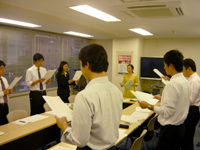Today's Notables
Tokyo Office, Researching Speech
July 2011
Hisashi Furuichi
President and C.E.O.
Unlike animals, human beings are unique in that we have vocal cords that allow for communication via the formation of words in spoken communication. The ability to communicate via language was acquired at least 250,000 years ago after the emergence of homo-sapiens. Even though man is far outnumbered by animals that are stronger, man as we know today has developed and gained control of the earth because of advanced communication and intelligence. Although weak individually, we can communicate in order to cooperate to solve many of the difficulties we have faced since the dawning of man. Therefore in order to survive in a society, communication with friends and family is an absolute necessity, as it is in the workplace. At the heart of this communication is "conversation." Each person has his or her own speech idiosyncrasies that our family, whom we share the majority of our lives with, grow accustomed to and can understand an individual's speech patterns or what is being expressed. However, with strangers, we often encounter patterns of speech that are unfamiliar, difficult to hear or understand. In business particularly, the ability to converse coherently and concisely not only makes work more effective, it elicits a positive feeling from the interlocutor.

With these principles in mind, the Tokyo office is addressing a new topic, namely, "Speech Pro," in which we have a professional announcer come to the office and implement training on effective speaking techniques. The instructor is a former announcer for Fukushima Broadcasting, who is currently teaching a an announcing training school at a affiliate of Asahi Television. Her name is Sakaya Sato. All twenty employees at the Toyko office are taking the course, divided into two groups once per month for a total of 10 training sessions in the program.

The class begins with pronunciation practice each
time, repeating "a, e, i, u, e, o, a, o," "o, a,
o, e, u, i, e, a" "ka, ke, ki, ku, ke, ko, ka, ko,"
and "ko, ka, ko, ke, ku, ki, ke, ka." Then she checks
each person's belly breathing, how to open the mouth, and facial
expressions. Also, she takes video of one minute speeches made by
the participants and the class points out the good points but also
areas that need more work. During the training, she teaches the
fundamentals of speech including long, middle, and close-up, and
discusses how to convey an idea by first giving an overall perspective.
Then she explained how to flesh out the idea, finally arriving at
the gist with some salient details to convey a clear concept. By
structuring conversation in this way, it is very easy for the interlocutor
to understand.
Initially, I mentioned that we practice by speaking for one minute
which may not seem like much, but it is more difficult that it appears
because a speech has a long, middle and close-up and delivering
an effective speech that has a good "lead-in" at the beginning
and a "drop" at the end, takes a significant amount of
practice. Ms. Sato's class is very enjoyable and for those of us
participating, it is almost like a game. The Tokyo Office was awarded
3rd place for last quarter greetings, but with this speech training,
I am sure we can take 1st. The next time you speak with someone
at the Tokyo office, listen carefully for modulation and smoothness
in speech.
We have asked Ms. Sato to be the master of ceremonies at the upcoming
Mixing Vision to be held in October of this year. I hope you enjoy it.
HOME > What’s New > Today's Notables > Details














